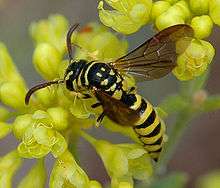Sapygidae
| Sapygidae | |
|---|---|
 | |
| female Eusapyga verticalis on Eriogonum | |
| Scientific classification | |
| Kingdom: | Animalia |
| Phylum: | Arthropoda |
| Class: | Insecta |
| Order: | Hymenoptera |
| Suborder: | Apocrita |
| Superfamily: | Vespoidea |
| Family: | Sapygidae |
| Genera | |
| |
The Sapygidae are a family of solitary aculeate wasps. They are generally black wasps, similar in appearance to some Tiphiidae, with white or yellow markings developed to various degrees.
The female oviposits her eggs into the nests of solitary bees, and the developing larvae consume both the host larvae and the supply of food provided for them.
The Sapygidae are a small family with only about 80 species described, and they are not of major economic importance. However, some of their host species are important pollinators, and it may sometimes be necessary to control the level of predation on them.[1] (Peterson et al., 1992).
Fossil sapygids have been found in Upper Eocene Baltic amber (Brischke, 1886).
References
- ↑ Peterson, S.S., C.R. Baird, R. M. Bitner Parma and C. Idaho (1992). Current Status of the Alfalfa Leafcutting Bee, Megachile rotundata, as a Pollinator of Alfalfa Seed. Bee Science 2:135-142. http://www.pollination.com/publications/IPSpub02.cfm
This article is issued from Wikipedia - version of the 9/12/2016. The text is available under the Creative Commons Attribution/Share Alike but additional terms may apply for the media files.